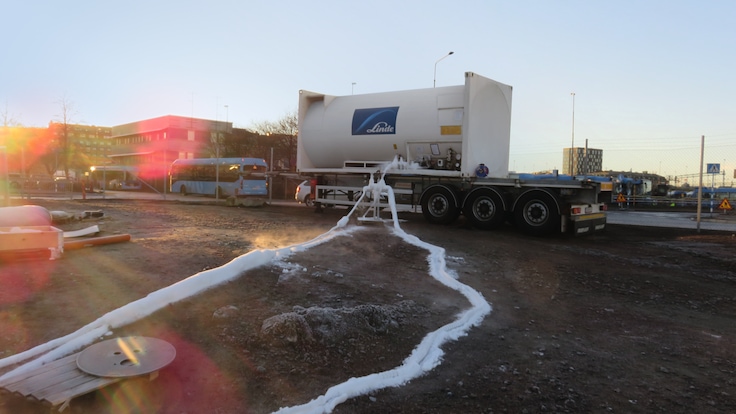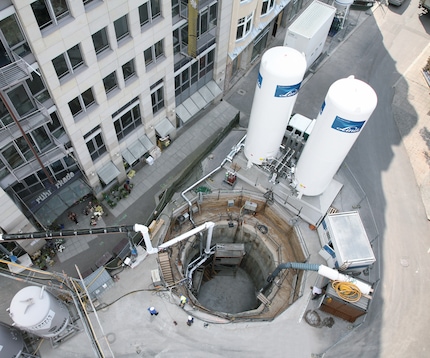
By partnering with CarbonCure Technologies, Linde helps reduce the concrete industry’s carbon footprint.
Using lances and liquid nitrogen, Linde's artificial ground freezing solutions provide stability where it's naturally lacking.

Many who have had to endure a turbulent flight or a bout of seasickness often hail the return to “terra firma” - the relative safety and security of solid ground. The American playwright and Pulitzer Prize winner George S. Kaufman even formulated a joke from the phenomenon: “I like terra firma. The more firma, the less terra.” The underlying assumption being that you can trust the earth beneath your feet. When that assumption is violated, grave consequences can indeed follow. Any number of so-called sinkhole events - where unstable ground has given way - can attest to this.
When ground is intentionally disturbed - during tunnelling operations in construction projects for example - stability becomes of paramount importance. “We know from building sandcastles as children, soft soil provides no structural strength,” says Ralf Schmand, expert in cryogenic applications & construction at Linde. “Artificial ground freezing (AGF) is a tried and tested means of improving the ground beneath, or indeed above, a build structure.”
That improvement comes in the form of strength and impermeability. Using liquid nitrogen (LIN), the ground water that fills the voids between soil particles - be it clay, silt, sand, gravel or cobbles - is frozen, binding the particles together. But beyond simply supplying LIN, Linde has developed an innovative lance portfolio offering the perfect fit for different freezing tasks.
“Weak soil, loose sediment and water ingress all pose pressing challenges to any excavation or underground construction project,” explains Schmand, “Through targeted ground freezing we protect the working area with a frozen wall of water.” First, so-called freeze lances are inserted into drill holes. Inside those copper freeze lances is another copper down pipe. When LIN is flushed through from the above ground supply, it evaporates, takes the heat from the soil, and freezes the void water. The frost typically develops in a conical “pear” shape around the lance - but the lances can be inserted in any orientation. Temperature lances are also an important part of the installation: the readings from which control the LIN supply. All signals are connected to a control PLC with a remote online connection accessible by the project team. “A key benefit of our application is its flexibility,” says Schmand. “We have various design options to influence the shape of the frost body, the nitrogen consumption and the freezing time.” Linde’s AGF Eco for example reduces the volume of LIN required while the AGF Trim lances are designed to be easily removed when tunnel boring machines approach them. Such flexibility is required to match the variety of customer requests. Much like medical surgery, AGF can be scheduled or used in response to an emergency - like collapses or rescues after unexpected problems. As Schmand points out: “We have designs to fit tunnels, excavation pits, gap closures, cryogenic soil sampling, repairing collapses … and much more.”

Having successfully delivered a variety of different and complex projects around the world, Linde’s AGF experts have gained vast, hands-on expertise in this area. “We currently have a 140-project strong track record,” says Schmand. “In a game where the ground must be trusted 100%, so too must the cryogenic experts,” he adds.
One current construction project located relatively close to Linde’s Munich HQ home is the Brenner Base Tunnel: an ambitious construction project connecting Verona (Italy) and Munich (Germany) through Austria which, at 64km, will become the longest underground railway connection in the world. But, as Schmand explains, there was a challenge: “The Isarco river is located on the new tunnel route, so the Brenner Base Tunnel Consortium needed a safe and sustainable way of building under the riverbed without having to deviate its path.” And Linde Gas Italia delivered. By first freezing the groundwater under the riverbed with LIN and then circulating saline brine to maintain the required temperature range of -30 and -35 °C, excavation work could proceed.
Elsewhere in Italy, Linde’s construction and cryogenic expertise has been called in for the construction of Milan’s new M4 subway line where AGF was employed to prevent cave-in during excavation work.
Heading further north, AGF was able to get construction work back on track for a railway tunnel that will run under central Gothenburg. The NCC Group - one of the leading construction companies in the Nordics - was chosen for the job but they soon turned to Linde for advice and assistance after encountering a challenge. “NCC needed to connect a service shaft to the main tunnel - which effectively ‘floats’ in the mud”, says Schmand, “But when trying to fill the gap using an omega seal, they ran into problems with water leakage.” Using Eco lances, Linde was able to come to the rescue with a quick and effective AGF solution allowing the customer to make up for lost time.
Delivering a full-service, turnkey package for AGF is just one way in which Linde provides a solid foundation for the construction industry - as Schmand lays out: “Our full-service offering extends from core cryogenic and water treatment solutions to a host of welding, joining and cutting gases plus equipment.” But no matter the sector, Linde backs up its extensive product, equipment, and supply system portfolio with in-depth expertise. In the case of ground freezing, literally so.

By partnering with CarbonCure Technologies, Linde helps reduce the concrete industry’s carbon footprint.

Discover how Linde helps construction companies manage cost and productivity drivers with gases for concrete curing, concrete cooling, ground freezing, pipeline isolation, water treatment and more

Discover how critical ground areas around construction sites can be frozen with liquid nitrogen (LIN) from Linde to stabilize the soil for safety and engineering reasons